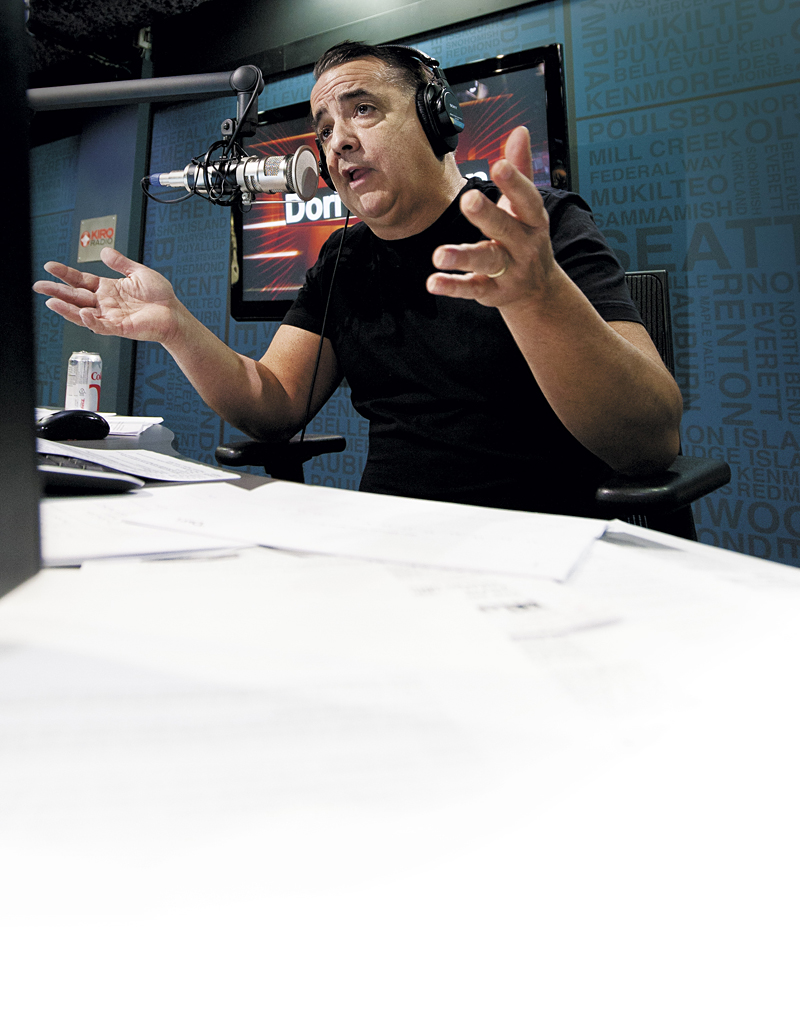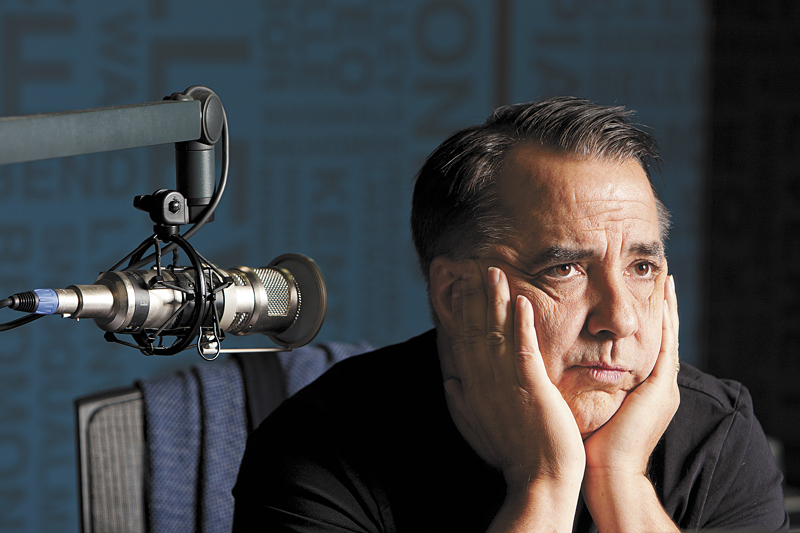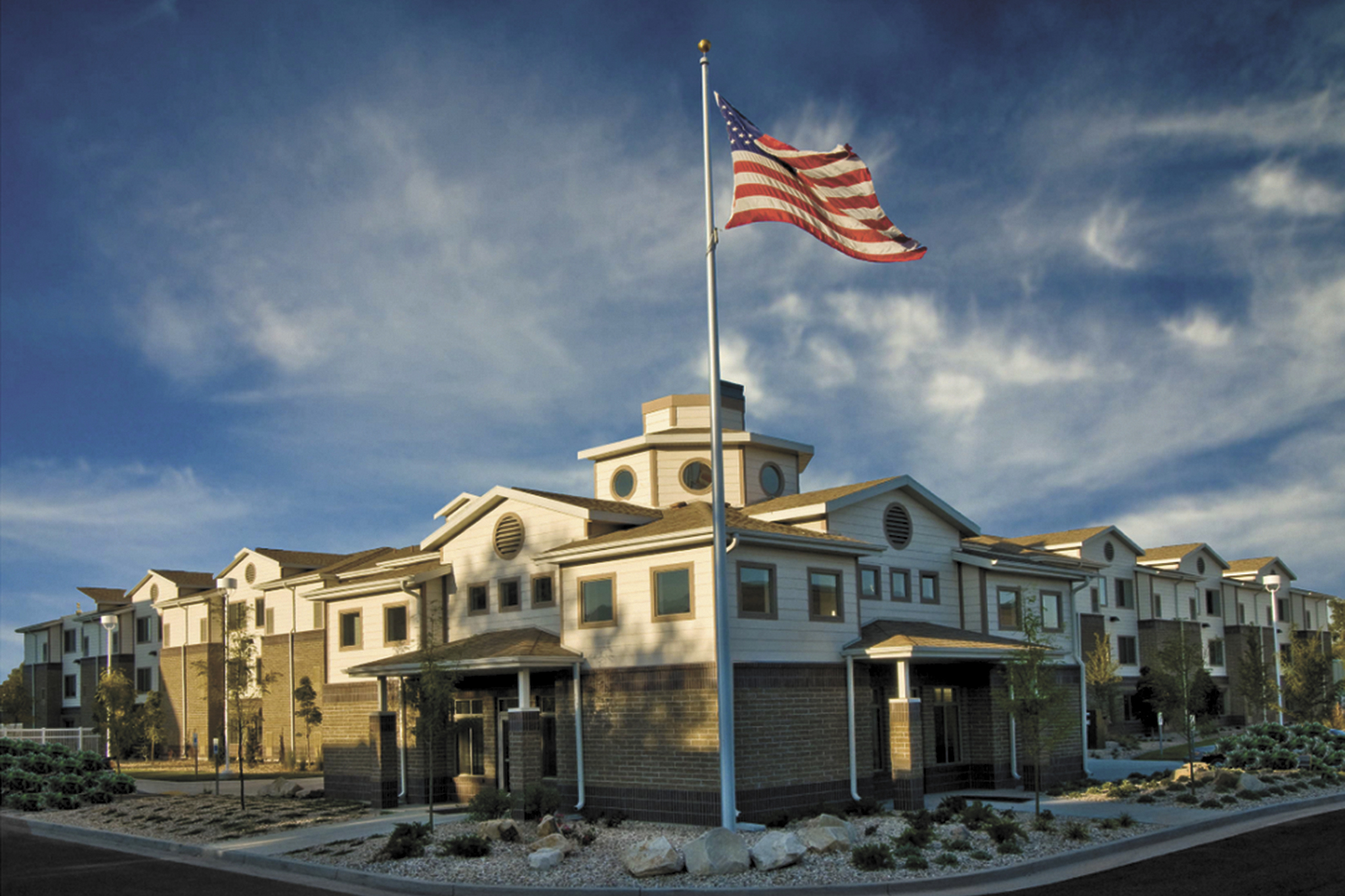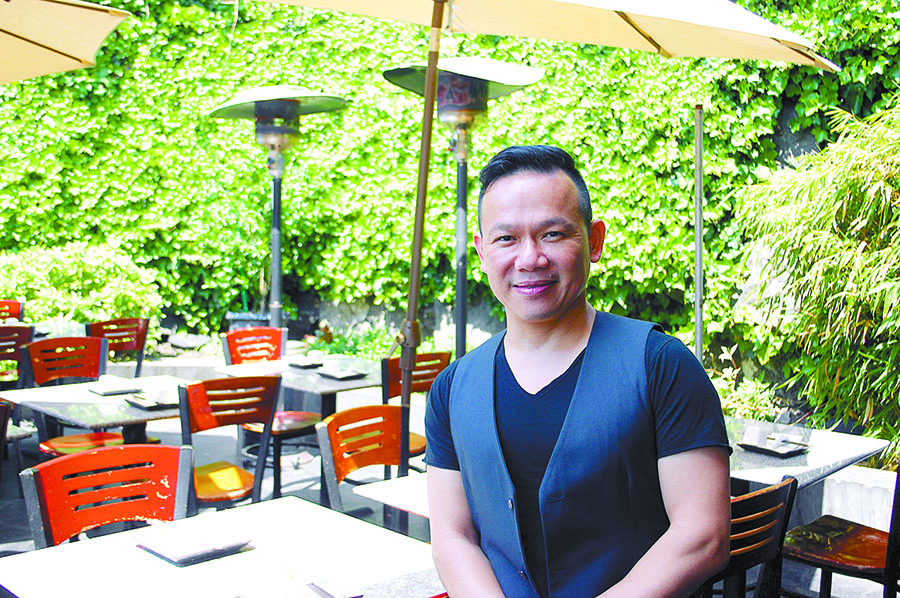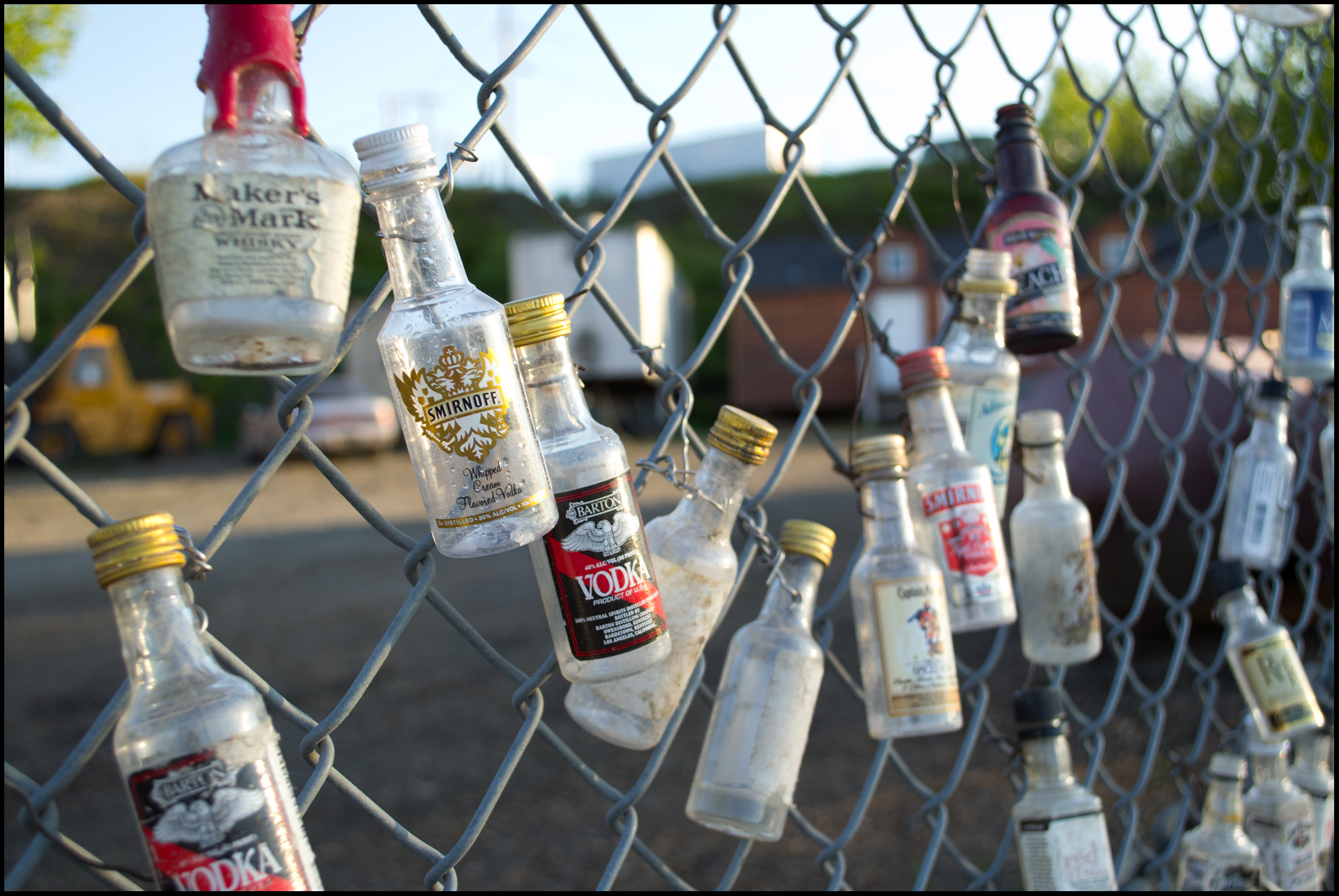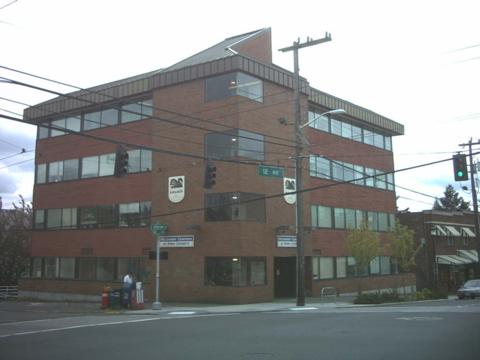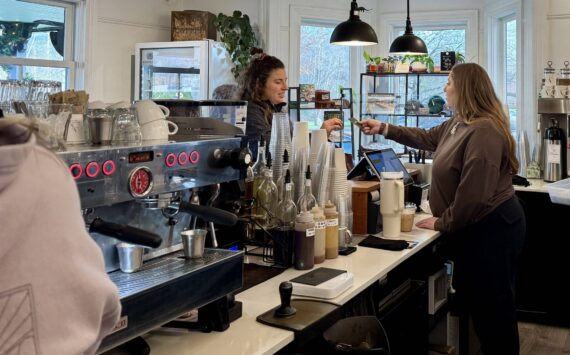On a late-October morning, The Dori Monson Show, or The Big Show, as Monson refers to his three rollicking, ranting, and often riotously funny hours at the microphone, is in its final stages before liftoff. He moves gingerly into the Eastlake studio, a Diet Coke in one hand, his gym bag in the other. Monson’s just finished a hunk of cold chicken breast, and now, after showering off the sweat from his daily workout, he straps on his earphones as the noontime CBS News on the Hour winds to an end.
As usual, Monson’s been up half the night prepping for his next day’s radio talk show on KIRO-FM (97.3) and watching reruns of Seinfeld and M*A*S*H. His need for stimulation is constant. When at last he turns in for a few blessed hours of shut-eye, he invariably tunes to Howard Stern to get him through the night.
“It’s always been this way,” says Suzanne Monson, the talk-radio host’s radiant, blonde wife of 25 years who thanks God earbuds were invented. “He’s a bad sleeper. When we first married, he was listening to Larry King in the dead of night.”
The one time he took a sleep aid, KIRO Radio newswoman Ursula Reutin recalls, he overslept and arrived late to the Seahawks pregame show he hosts with former Seahawks linebacker Dave Wyman. He burped into the mike, Reutin says, then proceeded to refer to the Houston Texans and the Houston Reckons. So now he just subsists on minimal sleep and a constant supply of Diet Coke.
A couple of hours before showtime, KIRO’s six-figure insomniac arrives at the studio and descends a flight of stairs into a former storage area that KIRO has turned into Monson’s cluttered basement hideaway. This is where Monson and his 28-year-old producer Jake Skorheim huddle each weekday morning, putting the last touches on the noon-to-3 p.m. program.
Monson stands 5 foot 9 inches. He has dark brooding eyes, a running back’s compact build, and a laugh that ranges from a giggle to a window-rattling gale. He’s 51 years old, and keeps himself in shape with two hours of full-court basketball at Shorecrest High School every Thursday evening—”My wife says it’s cheaper than a psychiatrist”—and 20 minutes of cardio each morning near his Lake Forest Park home before coming to the studio. When he arrives today, he’s still in a T-shirt and blue gym shorts that reveal thick, muscular calves.
He’s sleep-deprived, and the soda isn’t helping.
Over the din of FOX News emanating from the flat-screen, Monson peruses his favorite websites—Drudge, Blaze, Gawker, Yahoo, TMZ, and the London Daily Mail, looking for possible show-stuffers. Monson is always on the hunt for shocking, hilarious audio feeds or “trending” stories told around the proverbial water cooler—those man-bite-dog goodies that are the stuff of the viral Web.
“If I don’t have enough to do a show, I can’t sleep,” Monson ruminates as he continues to surf for something madcap. Past fodder has included the lady who’s addicted to drinking her own urine, which he had a field day with one March afternoon, or, more recently, ABC’s Diane Sawyer’s boozy election-night behavior, which he treated with with a playfully wicked segment, complete with game-show music, that he dubbed “Diane Sawyer: Drunk, High, or Really Tired?”
Monson can’t resist rehashing the breathless news that the Elmo puppeteer was relieved of his duties on Sesame Street for an alleged relationship with a 16-year-old boy, and that an Arizona Obama-hater had hopped in her Jeep and run her husband over for not voting for Mitt Romney.
For this show, Monson is working up a full-on rant about longtime Snohomish County Judge Timothy Ryan, who, it has been determined, will not face DUI charges, despite police reports that his speech was slurred and his eyes bloodshot.
Monson is a master chef when it comes to taking these slabs of news, capturing their essence, turning them upside down and inside out, and roasting them thoroughly. “Judge Ryan claims not to know the law!” Monson will fume during the show. One can almost hear his fans in radioland applauding. “He was asking the cop to do something illegal! I say this guy is not fit to be a judge! He behaved in a sleazy manner!”
No Monson performance is complete without something “creepy” to impart. The most entertaining shows invariably involve a “perv” or “a whack job,” or a you-gotta-be-shitting-me tale that’s “horrific,” “insane,” “sleazy”—or, best of all, just plain “sick, sick, sick!”
“I never say anything on the air that I don’t believe,” says Monson. Then, with a mischievous grin, he cracks, “I may exaggerate, but that’s for dramatic effect.”
“He’s a respected professional,” says Michael Harrington, editor of Talkers Magazine, a nonpartisan trade publication serving the national broadcasting community. “He’s a solid performer. He can be brash and controversial, but compared to the Michael Savages, the Limbaughs, well . . . I mean, 17 years with the same show. That’s an accomplishment.”
Professional, dramatist, performer, whatever. High ratings for The Big Show make clear that the crusty and conservative Monson—revered by some, reviled by others—is an on-air tempest that Seattle can’t tune out.
Monson takes palpable pleasure in skewering anyone he perceives as abusing his or her authority. In recent years, he’s directed much of his wrath toward the political left, reveling in irritating the hell out of them. As local media watchdog BlatherWatch puts it, “Monson’s shtick is sustained outrage.”
The website—whose motto is “Listening to talk radio so you don’t have to”—has been harshly critical of Monson through the years. Serving red meat to the anti-Monson crowd, the site’s writers have penned dozens of blistering posts, many of them mocking what they say is the host’s penchant for puerility: repeatedly playing audio clips of flatulence and the like. Contributor Stephanie Miller called Monson a “media whore” who’s become a “Lars Larson wannabe.”
But it’s his shift to the right that’s brought most of the scorn from critics like BlatherWatch. Monson had been a centrist Democrat, voting for Carter, Dukakis, Clinton, and Gore. But following 9/11, he became an outspoken supporter of the invasion of Iraq, voting for George W. Bush in 2004 and then libertarian standard-bearer Bob Barr in 2008.
“I started to become more devoted to a belief in self-sufficiency, and that government wasn’t the answer to all our problems,” Monson, a Romney supporter this time, says of his change.
Sound Transit is a frequent Monson target these days, as is the city’s obsession with high-density development, road diets, and bicycle lanes. Most anything to do with public employees’ or teachers’ unions is also a common target. And he has nothing but scorn for King County’s “critical areas ordinance,” which requires rural landowners to leave up to two-thirds of their property untouched. “I think our government leaders are more interested in creating a dependency on their benevolence,” says Monson, who once asked a startled state Democratic Party chief Dwight Pelz if he was a communist.
Gov. Christine Gregoire has been an ongoing recipient of Monson’s fire, along with Rep. Jim McDermott and former King County Executive Ron Sims—all shameless caretakers and defenders, Monson argues, of the dreaded “nanny state.”
At the 2008 Democratic convention in Denver, Monson sparred with then–Seattle Mayor Greg Nickels. “I asked him whether he could give me one example of how freedom and liberty for the people of Seattle had been expanded on his watch. Finally, he answered, ‘Well, we’ve been leaders in trying to stop global warning.’ And so I pressed him, and he just stormed off. He was pretty mad.”
Nickels says he has no recollection of the encounter, but adds, “I have a hard time taking him seriously. This guy is not a newsman, and he’s not a journalist. He’s an entertainer.”
Indeed he is. He once went live on the air, his voice quivering, as he stepped up to the ledge for a bungee jump in Nanaimo, B.C. He’s broadcast his skydiving exploits live on the air, as well as zip-lining, hang-gliding, and driving a stock car 140 mph at a Las Vegas track. Famously, he had himself Tasered by a cop years ago, right there in KIRO’s Eastlake Avenue studio, treating loyal listeners to real-time shrieks and moans.
Monson’s show has changed in tone and direction over the years, easing off political stories in favor of more widely palatable fare, prompted by the show’s April 2009 move from AM to FM. Switching bands made Monson accessible to a younger demographic more receptive to the off-the-wall, the oddball, and the outrageous than the government-run-amok stories of years past.
In early October, a German liquor company, G-Spirits, launched lines of rum, vodka, and whiskey with a sexy guarantee—all its beverages had been poured over a glamorous model’s naked breasts—to be had for up to $177 a bottle. On his show, after teeing up the spirited tale, Monson pulled off his shirt and poured a can of Diet Coke over himself, promising listeners that the erotically charged soda running down his bare chest could be had for a whole lot less than $177.
What prompts him to pull these crazy stunts?
“Ratings,” he deadpans.
Monson has a reputation as someone who often runs hot and shoots from the hip. But he is always well-prepared and “shockingly informed,” as one colleague describes him.
“Dori has a native Seattleite’s mentality,” says KIRO Radio news director Pete Gammell, “and he has struggles with all the changes—going from blue-collar town, where we had a lot of maritime industries and so on, to a more high-tech culture.”
The Seattle markers that were important to Monson, adds Gammell, have vanished: the Fun Forest at Seattle Center; J.P. Patches; the Jetsons-style Denny’s on Market Street; Zesto’s and the Dog House; the Seattle Pilots playing ball at Sick’s Stadium. “Dori is sort of an historian of old-Seattle pop culture, and he has a profound respect for institutions.”
“I do despair for the qualities we’ve lost as a city,” says Monson. “The things I saw as a kid, the fierce independence, and hardworking people who didn’t rely on government. I’m disappointed that we’ve lost that spirit.”
Monson was furious when in early April a group of protesters calling themselves the Seattle Solidarity Network marched on the nearly 90-year-old Borracchini’s Bakery in the Rainier Valley. The SeaSol demonstrators demanded that owner Remo Borracchini pay nearly $8,000 to a worker whom he’d axed for repeatedly being rude to customers—money, they claimed, she was entitled to for breaks she supposedly had been denied.
Armed with surveillance videos showing the woman in question taking 10- or 15-minute breaks, a livid Monson took to the airwaves and implored his listeners to head to the bakery the following Saturday morning and show their support. Hundreds heeded Monson’s call, sparking a tense standoff between protesters and people buying a lot of doughnuts.
One of the host’s most legendary pot-stirring displays took place in the fall of 1998 during the Clinton impeachment hearings. Monson, who voted for Clinton in ’92 and ’96 and still thinks he was a fine president “and brilliant man,” thought the hearings were nothing more than a witch-hunt. “So I decided to do a parody of the Senate prayer that the chaplain would give before any kind of Senate proceeding would begin. And I said something like, ‘Oh, Lord, please help us remove that scumbag Bill Clinton from office,’ ” Monson recalls. “Our senators [Patty Murray and Slade Gorton] got hundreds of calls—and then the Senate chaplain actually called into the show, and he demanded an apology. And I wouldn’t give him one.”
The Senate chaplain at the time was the Rev. Lloyd John Ogilvie. Reached by phone in California, Ogilvie, now 82 and a part-time inspirational speaker, would only say of Monson’s knee-slapping blasphemy, “Oh, yes, I remember, but I’ve tried to block it out of my mind.”
There’s one show that Monson might never completely empty his mind of. A 14-year-old girl named Yvonne called—a day after the April 20, 1999 Columbine massacre in which 12 students and a teacher were murdered by a couple of deranged social outcasts at the Colorado high school. “She said she was thinking of doing the same thing,” Monson recalls. “She said something like, ‘Oh, I know where the guns are.’ We ended up talking for 20 minutes. We blew out the commercials and the CBS News and just kept talking.”
Monson said he reached out to listeners that afternoon, asking if they might find someone who could offer the girl professional help. “And finally we were able to connect her with someone who came on the air—and then we put them together.”
Says Monson, “It was the most chilling call I’ve ever had.”
It’s a late Monday afternoon, two days before Halloween, and Monson is drained, as he often is when he finishes his show. He takes a seat at a table in the food court at Third Place Books and sips his Diet Coke. Off the air, Monson is engaging, warm, surprisingly laid-back, and “devoutly nonconfrontational”—in dramatic contrast to his gusty on-air persona. “I never talk politics off the air, because there are a lot of people here who can’t just stop at just disagreeing with you,” Monson says. “No, they have to say ‘I disagree with you, therefore I hate you.’ “
Monson was born on October 2, 1961, and raised “on the mean streets of Ballard,” as he often regales his audience. It always sounds like he’s kidding—and really, he is, for the most part—but wrenching memories do linger from those early days.
His father, a paratrooper, lost a kneecap at Normandy. A drinker, he was hardly ever around. Not an angry or abusive drunk, he’d just grow silent, distant. “He was a grocery-store worker, when he had a job. He was up in Ketchikan, mostly,” Monson says. “I never tried to understand him.”
Monson was a teetotaler until he was 40. It was a conscious decision, he says. He’s never smoked a cigarette or a joint or snorted a line of coke. “I’m not sure I’ve ever even had the equivalent of a full beer.”
He grew up poor. The power was shut off regularly at his house on Sunset Hill. For a time, the family—an older brother and sister and Sylvia, his stay-at-home mom—got by without a water heater. She’d get the water boiling on the stove and pour it into the tub. He can’t remember if his dad ever wired money from Alaska. He loved going to friends’ houses, “friends who had traditional homes,” and he’d later vow to have a stable home of his own.
In the absence of his father, other men stepped up to guide the young Monson, men for whom he still feels immense gratitude. When Monson was 9, Gene Caruso drafted him to play for his Loyal Realty team, buying the boy a glove when he saw the one Dori had couldn’t catch a ball. Monson kept the glove until he left it behind at a ballfield in Issaquah eight years ago—a heartbreaking mistake to this day. There was also Earl Kelly, his high-school drama teacher, who first taught him the wonders of a great performance and who implored Monson to go to college before becoming an actor.
Monson was a precocious child, attending kindergarten at the Evergreen School for Gifted Children—when he was 3. Between riding his bike to the Dog House, hanging out at Golden Gardens, and playing pinball at Zesto’s, young Dori spent three years reading a complete set of the World Book Encyclopedia. He moved quickly through school, taking accelerated programs at Whittier Elementary, James Monroe Junior High, and Ballard High, from where he graduated at age 15. A year later, Monson was taking classes at Shoreline Community College and working as a manager at a Capitol Hill warehouse, where, for a while, he thought of making a career of it.
But one day at the warehouse, Monson heard a radio ad for the Ron Bailie School of Broadcasting, which Bailie had started in his garage while working at KJR in 1963. For a kid who’d taken a liking to acting and who used to fall asleep listening to Larry King, the natural-born storyteller whom Monson dreamed of emulating, the Bailie school was enticing.
With a student loan, Monson paid $3,495 for the one-year program at Bailie—whose founders in 2006 would be sentenced to several years in prison for embezzling student-loan repayments. “Biggest waste of money in my life,” Monson says with a grin.
But questionable as it was, it was at Bailie, located on Denny Way near the Pacific Science Center, where Monson one day met a special guest speaker, longtime radio man Bill O’Mara—and that changed everything.
The Monson home, where they’ve lived since 2004, is tucked away in the woods of Lake Forest Park. It’s a lovely Northwest craftsman, big and airy. On this late-autumn morning, the icy-blue skies are vast, cluttered with slow-moving clouds that throw rolling shadows over the surfaced sports court where the ever-competitive Monson plays horse with his best buddy Wyman, who confides that Dori “has a really ugly shot.”
The backyard is three-quarters of an acre of richly maintained grass, which Monson mows on a rider, Springsteen blasting through his earbuds. Here, Suzanne Monson square-danced the night away on her 50th birthday. Bird feeders are attached to a shepherd’s pole, near the rope swing which dangles from a towering black walnut.
Suzanne, a former Seattle Times writer who continues to freelance, figures she tunes into The Big Show about 60 percent of the time. “If I listen to it, then when he comes through the door, I won’t have to ask him how his day went, because I’ll know. It’s a bad day when maybe he didn’t have enough material that got him jazzed up, or he put a lot of work into a segment and it fell flat and maybe didn’t get a good rating. Or when he gets beat [in the ratings] by a competitor like [Michael] Medved [on KTTH 770 AM, noon to 3 p.m.]. He really, really hates that. He wants to win.”
Out on the deck, where Dori decompresses after the show before racing off to coach his varsity high-school squad, the Shorecrest Scots, Suzanne cheerily shows off the barbecue and smoker—the closest he gets to vegetables is an occasional Caesar salad. This is also where he engages in his newest hobby: bird-watching. An accomplished pianist, Dori finds tension relief, says Suzanne, by retreating to the library, dominated by John Grisham novels and horse-racing books, and “attacking Billy Joel” on the grand piano, where he pounds out “Piano Man” and other hits.
Suzanne says that what drew her to Dori, and what continues to happily fuel their marriage, is his “childlike, boyish spontaneity. He’s a big kid. And in our real life, he’s the most useful, enthusiastic person I know . . . It was on our second date when I told him ‘You are the best storyteller! Just the best.’ “
A deeply emotional family man, Monson hasn’t been able to pass the former bedroom of their second-oldest child without crying since September, when she left for a University of Washington sorority house. He wept in front of close friends at his 50th-birthday celebration last year. He gets teary-eyed when a winner is crowned on American Idol.
“He gets choked up pretty easily,” says Wyman.
Dori’s home office is a tangled mess of old shoes, gym bags, basketballs. There’s a stack of Sports Illustrateds, back issues of Forbes and Fortune. There’s also a worn copy of his beloved Ball Four, ex–major leaguer Jim Bouton’s subversive memoir of his 1969 season at Sick’s Stadium during the Pilots’ only year in existence. Dori rereads the book every year.
A blinking “Welcome to Las Vegas” light is fastened to one wall; another is covered with sports paraphernalia: framed photos of Mickey Mantle, Ted Williams, and Willie Mays and a gallery displaying many of the players, his own daughters included, from his 17 years of coaching. Encased in glass atop a bookshelf is a model figure of Baltimore Orioles great Brooks Robinson.
“He’s a numbers guy,” notes Suzanne. “That’s why he loves Vegas so much. He can’t remember names to save his soul. I can’t even send him to the grocery store; he won’t remember the neighbor’s name. I have to tell him the names of his cousins. But he can tell you Brooks Robinson’s stats for every year he played.”
Says Monson: “When I was 10 or 11, I knew every batting average of every major-league player at the end of the season.”
Monson often demonstrates on-air his prowess with numbers. On a recent show, when producer Skorheim noted that Angus T. Jones, who plays the kid on CBS’ Two and a Half Men, makes $250,000 per episode for 34 episodes, Monson immediately replied, “Well, that’s $8.5 million.”
Marvels KIRO’s Gammell, “When it comes to probability and statistics, he’s like Rain Man.”
Bill O’Mara began his remarkable radio career in 1939, and in the late 1940s headed west to become the first sports director at KING-5 TV. He did it all: worked TV and radio in San Diego, served as the Seattle Rainiers’ play-by-play man, called Seafair hydroplane races in the ’50s. At age 90, O’Mara, the country’s oldest working sportscaster, was still broadcasting high-school football and basketball games on KLKI in Anacortes.
“In 1979,” Monson wrote in a blog post several years ago, “God decided to send this strange, toupee-wearing, tough-talking, grizzled angel into my life. He was a broadcast lifer working at KWYZ ‘Radio 124’ in Everett. I was a 17-year-old kid who had no direction in life.”
Monson was one of 31 Edward R. Murrow wannabes at the Bailie School when O’Mara came to speak. For some reason, O’Mara took a liking to Monson and offered him an internship. “But he said he’d give it to me on one condition: I’d have to enroll at the University of Washington and get my college degree,” Monson recounts.
He did so, but at $600 a quarter, the dirt-poor kid from Ballard’s mean streets soon was broke. “I told him I was out of money after that first quarter, and had to quit and go back to work full-time,” Monson goes on. “So one night, I’m living at home still, and he comes rolling up in his old Renault, and he bangs on the door. He says he wants me to reconsider. And then this old guy, who was so poor himself that he was sleeping at KWYZ, peels off six $100 bills.” Later, O’Mara would introduce Monson to King Broadcasting Company owner Dorothy Bullitt, prepping his launch onto the Seattle airwaves.
Shortly before O’Mara died in August 2009, Monson visited him at the hospice ward at Stevens Hospital. “I held his hand and I thanked him for my life,” Monson whispers. “I told him I’d have never gone back to school without him, and so I wouldn’t have met my wife, and wouldn’t have had three daughters. I told him that without his help that night, I wouldn’t have met Dorothy Bullitt, which led me to get an internship at KING-5—and which would lead to my talk show at KIRO. I don’t know, but I think he heard me.”
As a hungry kid hoping to break into the profession, Monson’s first encounter with the powerful Bullitt couldn’t have gone much better. He recalls with a laugh the first thing Bullitt ever said to him: ” ‘Kid, you got nice eyes. I want you to work here someday.’ Those were my Forrest Gump days.”
At KING-TV, Monson moved up the ladder to executive sports editor. He also did a morning sports show on long-gone KING-AM (News Talk 1090). Though the money was far better in TV, he knew radio was the best vehicle for storytellers like himself. Soon he was forced to choose paths. “One day the TV news director comes to me and says I have to quit the radio job,” remembers Monson. “He was just pissed at Tony Ventrella [at the time, sports director at KING-TV] about something, and he knew I was good friends with him—so that was his way of getting back at him.”
Monson went to KING-AM program director Steve Wexler and told him he was quitting the TV gig and wanted a radio show on the “Mighty 1090.” “He said no, that we’re probably going to go with someone else.” Growing desperate, Monson went back and said, “Just give me 30 days.”
Wexler, now executive vice president at Journal Broadcasting in Milwaukee, recalls Monson’s plea. “I remember I said, ‘OK, let’s see how it goes.’ I remember, too, that he was different. He had a real good way of telling a story, and a sense of humor about everyday life.”
After the Bullitt family sold KING-AM to Salt Lake City–based Bonneville International in 1994, Monson moved to KIRO. After working for a time on The Pat Cashman Show on KIRO-AM, Monson was given his own show, now in its 17th year.
On Halloween morning, Monson is all business. The show is minutes away, and he runs down the stories he’ll use for his opening nine minutes—The Big Lead, as he calls it.
“OK, we got the DUI judge, the liquor-store thefts, and let’s go with the audio of the little girl crying about the presidential race,” he tells Skorheim, moments after settling into his chair and adjusting the mike. The Diet Cokes are kicking in now. He’s ready to roar.
For the 12:45-to-12:53 segment, Monson has penciled in audio of a young drunken woman who enters a store and starts talking trash to the customers. It ends with her getting the bejesus beaten out of her by a female patron who can’t stomach her insane ramblings a minute longer.
Monson lets out a hearty laugh as he listens to a portion of the audio, in which the vanquished woman, now sounding sober as a church mouse, whimpers, “I got hit, like, 47 times. My head hurts really bad . . . Goddammit, that sucks.”
“Yeah, that’s going to be good,” Monson mutters happily. “We bleeped a lot of that out, right, Jake?”
At 12:03, the local news concludes and Monson is set to begin his rabble-rousing communion.
“It’s another gray day in the great Pacific Northwest,” Monson gleefully begins. “Welcome! Welcome to The Big Show!”
